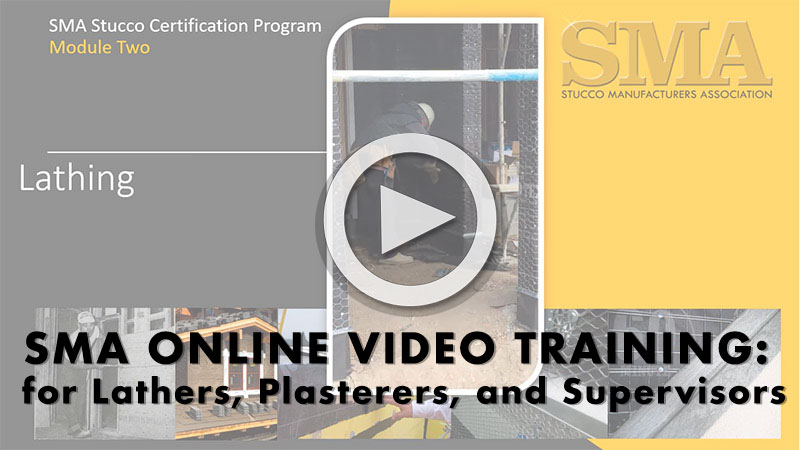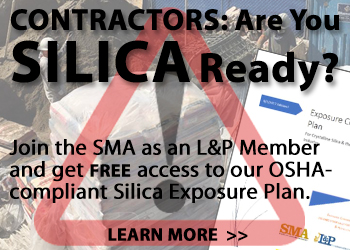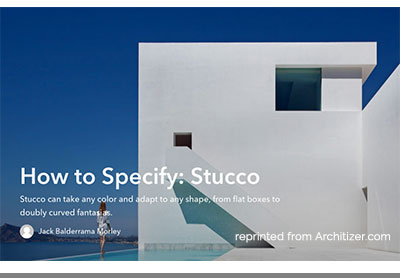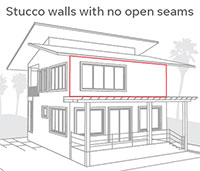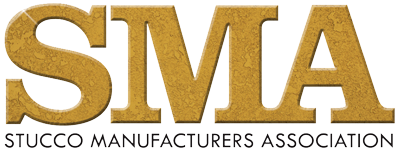PRESIDENT’S LETTER: Getting Involved
Kevin Wensel, Omega Products International
 After many difficult years, it appears the construction industry has finally turned the corner. In almost all markets there has been a steady, broad-based improvement in the number of building permits issued. As construction increases, many suppliers and contractors are struggling to keep up. Most businesses cut staff during the downturn and, even with this increase in building, have not replaced many of those workers. That leaves the remaining staff overworked. With little spare time, involvement in industry groups and events tends to get sacrificed. I would challenge you not to let that happen.
After many difficult years, it appears the construction industry has finally turned the corner. In almost all markets there has been a steady, broad-based improvement in the number of building permits issued. As construction increases, many suppliers and contractors are struggling to keep up. Most businesses cut staff during the downturn and, even with this increase in building, have not replaced many of those workers. That leaves the remaining staff overworked. With little spare time, involvement in industry groups and events tends to get sacrificed. I would challenge you not to let that happen.
Being involved will not only help your company, but will better the industry as a whole. At the SMA, our goal is to promote and support the plaster industry. We want to be the national voice for everything related to plaster, including color coat, three coat, one coat, and accessories. In the last year we have made great strides toward that goal with the establishment of the One Coat and Three Coat Committees. All members are encouraged to participate in these committees. They are a forum to discuss issues that involve the plaster industry and work as a group to resolve challenges that face our membership.
There are many challenges facing the plaster industry in the next few years. Probably most pressing are the upcoming changes to the energy and building codes that may profoundly impact the way plaster systems are installed in many areas of the United States. Challenges like this are best addressed as an industry and the SMA is the organization to make that happen.
These are exciting times for the SMA. I encourage you to become involved and invite others to participate also. Together we can all make the plaster industry stronger.
![]()
SMA First Annual Golf Tournament — Highlights
One could not have asked for a more beautiful day to play in the SMA first annual golf tournament. We had a full 18 holes, a magnificent day to be outside, lots of fun and great food. Oh yes, don’t forget the raffle items. Strawberry Farms in Irvine rolled out the red carpet for us, and they couldn’t have been nicer. We look forward to working with them next year for the second annual golf tournament — SAVE THE DATE for September 18, 2014!
Here are your winners:
First Place:
Vince Overmeyer, Paul Maag, Jim Tunstill and Brian Ott
Second Place:
Louis Corpolongo, Mr. Shrimp Sr., Eric Shrimp and Mr. Hoffman
Third Place Tie:
Jose Castellon, Walt Niestemski, Doug Dalton, Steve Hreha and Scott Robeson, Rick Edwards
Closest to the Pin: Jim Tunstill on #17 and Mr. Shuck on #11
Longest Drive: Tim McGuire
Putting Contest: Vince Overmeyer
I also want to thank our volunteers:
Ted Jones – MC
Tina McIntyre – TXI/Riverside Cement
Jim Gonzales – Putting Contest – TXI/Riverside Cement
Karine Galla – ParexUSA
Thank you to Jim Dean of P.W. Gillibrand for donating items for the raffle. Much appreciated. And thank you to all our sponsors who helped in raising money, a portion of which will be donated to Wounded Warriors. Thank you ALL.
GOLD
Omega Products International
Thompson Building Supply
ParexUSA, Inc.
SILVER
P.W. Gillibrand Co. Inc.
BRONZE
P. T. Hutchins
BMI Products
Merlex Stucco
Haver Filling Systems, Inc.
TXI, Inc.
Lhoist North America
Save the Date for Next Year: September 18, 2014
Tina McIntyre of TXI/Riverside Cement has agreed to work with SMA’s Executive Director Norma Fox to put together next year’s tournament. Anyone else who wishes to be on the committee please let Norma know.
EXECUTIVE DIRECTOR’S REPORT
Norma S. Fox, SMA Executive Director
 SMA is exploding and it is in a good way. We have picked up 18 new members since the beginning of summer. This is good! We have increased our board of directors from 7 to 9 and have formed working committees – Three Coat and One Coat. Our committees have started holding telephone conference calls and I have to tell you it is very exciting. 2014 is going to be a very good year for SMA. The committees will be focusing on issues facing their particular part of the stucco industry.
SMA is exploding and it is in a good way. We have picked up 18 new members since the beginning of summer. This is good! We have increased our board of directors from 7 to 9 and have formed working committees – Three Coat and One Coat. Our committees have started holding telephone conference calls and I have to tell you it is very exciting. 2014 is going to be a very good year for SMA. The committees will be focusing on issues facing their particular part of the stucco industry.
One Coat is looking to make a video to show the proper installation of one coat stucco which will go up on YouTube. They are also going to produce marketing literature from the association for distribution to the industry and the public at large. They will be dealing with regulations and issues of great importance. Out of this will come a number of Technical Papers. Supplier members are welcome to join in on these conference calls. I will send out notices to all members when a call is scheduled. Just let me know you want to be part of it, and I will send you the call-in info and agenda. This committee is chaired by Mike Griffin of Quikrete.
Three Coat has met as well via conference call. They are focusing on various rules and regulations that are changing in the industry, and along with WWCCA will work to produce Technical Papers and White Papers as needed. Any SMA member is welcome to participate in these phone meetings. Again, I will send out a notice prior to the meeting and when you let me know you want to be part of it, I will send you the info you need to do just that. This committee is chaired by Nick Brown.
The Board of Directors will be holding a full-day Strategic Planning Session in early December to set the future of the SMA. Our goal is to complete a five-year plan with a map of what we have to do and where we are going. The SMA is going to become a vital national association for stucco. We invite any other association in this industry to work with us to make stucco the viable product it is and the best product for construction.
We are looking for ideas for member meetings in 2014. If you have any suggestions please send them to me via email and I will discuss your idea with our board of directors.
I am happy to report to all our members that SMA for the fiscal year which ended on 9.30.13 was outstanding. We finished with a profit of $5,000. This is a first in a very long time. Yeah!!!!!!!!!!
We want to continue building the association and bringing in new members — so if any of you know folks or companies that should be members, talk to them and then give me the name of that company and the person I need to speak with to make it happen.
DON’T MISS OUR ANNUAL LOOK AT THE ECONOMY
Learn from our featured speaker, the respected economist Christopher Thornberg, Ph.D. — What’s Wrong (and Right) with the U.S. Economy. Sign up today!
FEATURE ARTICLES
Introducing Safety Compliance Stickers
AVOID FINES WITH SAFETY SIGNS. As a full-service Cal/OSHA compliance, consulting service and Cal/OSHA defense firm, EEAP The Safety People is introducing Safety Stickers to increase the safety awareness and compliance within your business. Fax us at 661 526 7832 or e-mail us at info@eeap.net with your order.

Vinyl Is the Most Common Siding on New Homes
Eye on Housing The National Association of Home Builders Blog
The most common exterior wall material was vinyl on homes started in 2012. Vinyl siding was used on 32 percent of the new homes started in 2012, followed by brick for 25 percent of homes. Stucco was the principal exterior wall material for at least 20 percent of the homes started according to the data from the Census Bureau’s Survey of Construction (SOC).
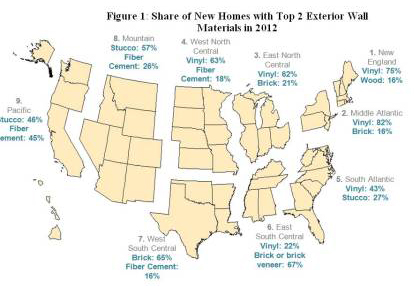
The SOC specifically collects data on whether the principal exterior wall material in a new home is vinyl siding (including vinyl-covered aluminum), brick or brick veneer, stucco, fiber cement siding (such as hardiplank or hardiboard), wood or wood products, stone, rock or other stone materials, and concrete block (not including stucco).
The Census Bureau’s SOC data is available by the nine census divisions. Vinyl siding was the most widely used primary exterior material in 6 out of 9 census division. In the Middle Atlantic and New England region, more than one-third of the new homes started used vinyl siding. The East and North West Central accounted for at least 62 percent while South Atlantic and East South Central accounted for 43 and 22 percent respectively.
Reprinted from The National Association of Home Builders Blog, October 8, 2013, eyeonhousing.wordpress.com.
Hot & Cold: Some helpful hints for the placement of plaster/stucco materials in both hot and cold conditions
Mike Griffin Member at large SMA Board of Directors and chair of One Coat Committee
Reprinted with permission of Walls & Ceilings Magazine.
Weather has a significant effect on the application requirements and nuances of plaster/stucco seasonally, and sometimes daily. Contributing factors are: temperature, humidity, wind and the exposure of the sun.
Every plasterer knows that plaster/stucco sets faster in the summer and slower in the winter. In this article the goal is to offer some helpful hints for the placement of plaster/stucco materials in both hot and cold conditions.
The cement used in plaster/stucco is hydraulic in nature, meaning the water mixed with the plaster is the catalyst for the chemical reaction that makes the material take on its initial set, get hard and subsequently cure. Hot weather poses a few challenges for plaster construction practices. As ambient temperatures rise and materials and equipment heat up during application, moisture evaporates more quickly therefore leaving less water for cement hydration. Losing the water too quickly can result in lower tensile strengths and cracking. ASTM C 926-Specification Standard for Application of Portland Cement Based Plaster requires wetting or fogging the wall between successive coats and for up to several days after the application to aid in the curing process. Heat, wind and humidity all play a big part in the limiting the curing process, and if the wall has not received a sufficient amount of watering and “fogging” during this process, a wall with soft material and excessive cracking may result if the plaster has dried out too quickly.
Hot Weather
Hot weather is defined as ambient temperature exceeding 1.00 degrees Fahrenheit (37.8 degrees Celsius) or 90 degrees F (32.2 degrees C) with a wind velocity greater than 8 mph (1.2.9 km per hour). Compounding factors include low relative humidity and direct sunshine. Below are some of the effects on the plaster:
• Workability is reduced
• More water is required for workability
• Initial and final set occur earlier
The result is that the plasterer can experience difficulty in placing and working the material. In addition to negatively affecting the workability, the rapid increase in drying time can result in a lack of sufficient water or proper hydration of the plaster. Inadequate hydration can result in a lack of strength development and contribute to the plaster cracking. The following techniques should be followed during hot weather installations:
• Schedule construction to avoid hot midday periods.
• Work earlier during the cooler temperatures (“run from the sun”).
• Minimize exposure of materials and equipment to direct sunlight.
• Use cool water to mix.
• Use cool water on shovels and mud boards.
• Control amount of plaster spread so as to not get too far a head of rodding/leveling wall surface
• Moist cure the plaster “fog the wall.”
• Protect the wall from uneven curing or exposure. Draping a tarp over the scaffold to shield the plaster during hot windy days is very effective.
Some other helpful hints for hot weather construction:
• Do not apply plaster/stucco to hot surfaces.
• Use plaster/stucco materials with optimal water retention, workability and consistency. Using a preblended plaster/stucco helps to achieve this and can be custom blended.
• Do not apply cementitious materials at temperatures above 100 degree F (37.8 degrees C) without preparations. Monitor the extended weather forecast during the installation and curing period for severe temperatures.
• Keep materials shaded to reduce temperatures upon installation.
Cold Weather
Plastering when the temperature is at or near freezing causes another set of problems for the contractor or installer. There are precautionary measures that can be taken to protect the project during cold adverse weather conditions. Extra care should be observed if the temperature is nor at least 40 degrees F (4.4 degrees C) and rising, or if the temperature drops below 32 degrees F (0 degrees C) after the wall has been plastered.
The International Building Code for cement plastering requires in Section 2512 that “plaster coats shall be protected from freezing for a period of not less than 24 hours after initial set has occurred. Plaster shall be applied when the ambient temperature is higher than 40 degrees F (4.4 degrees C) unless provisions are made to keep cement plaster work above 40 degrees F (4.4 degrees C) during application and 48 hours thereafter.” Similarly ACT 24, Guide to Cement Plastering, requires that, “Plaster installed when ambient temperatures are below 40 degrees F (4.4 degrees C) must be maintained in a sheltered and heated environment with continued curing to assure cement hydration.” At 32 degrees F (0 degrees C) and below, plaster will freeze on the wall and cause weakening of the plaster. Damage to the plaster can be so severe that you can rub it off the wall by using your hand.
Cold dry air on the surface of the wall can absorb warm moisture from the wall rapidly and can lead to plastic shrinkage cracks. Low temperatures can cause all cement plaster to take longer than normal to set and gain strength which delays floating, troweling and production which raises labor costs unnecessarily. If a wall has been frozen the resulting wall may have excessive porosity which can cause further deterioration during freeze thaw cycles if a driving rain hits it and it freezes. Cold conditions, as such, can also make the wall more susceptible to efflorescence forming on the surface of the wall. To counteract these cold weather problems several precautionary measures can be taken which may involve enclosing and hearing the structure.
When the cooler weather approaches a contractor should plan in advance and budget for enclosing and heating the project if necessary. This will reduce the effect of cold weather on plastering/stucco projects and increase the likelihood of successful project completion in freezing weather. When air temperatures start to fall towards the end of the year, special considerations/precautions need to be given to the installation/application of cement plaster/stucco. The application of cemetitious materials is typically restricted to temperature of 40 degrees F (4.4 degrees C) and rising. This minimum is critical to the proper curing and overall performance of the material. Application of materials in cold and freezing conditions can cause materials to crack, flake, soften and delaminate.
• Hydration of cement based materials is slower at cooler temperature.
• Set times of the material will be slower in cooler temperatures they may freeze or not set up at all.
• Strength development of the material can be reduced.
• Thermal fluctuations will cause movement in the substrate which can produce cracking. Any crack in the substrate including joints between substrate components is subject to movement. Thermal cycling and therefore maximum movement is at its highest frequency during the fall months. Cracks that appear narrow in the warmth of the afternoon (when substrates are expanded) may widen significantly during the night when the temperature falls. This thermal movement can cause surface cracking. (In repair/restoration situations the cracking can be even more severe as the patching material that fills in and around existing material has not developed full strength.)
Some helpful hints:
• Do not apply plaster/stucco to frozen surfaces.
• Do not apply cementitious materials at temperatures below 40 degree Fahrenheit without monitoring weather conditions. Monitor the extended weather forecast during the installation and curing period for severe temperature drops. Keep materials stored at 45 degrees F (7.2 degrees C) or higher if possible.
• Tenting and enclosures may need to be utilized for the proper application under cold conditions to avoid freezing and if they are pay close attention to enclose the entire application area to properly withstand wind and rain.
• Adequate ventilation should be engineered into the enclosure for safety and to provide for proper air movement for curing. Avoid using gas, kerosene or other fossil fuel heaters because they can cause rapid carbonation of cementitious material during initial set and cure.
• The heated enclosed area also needs to have the heat source run long enough before and after the application for proper conditioning and cure times.
• The temperature of the substrate also needs to be taken into consideration. Heating the mixing water up to 120 degrees F (84.4 degrees C) (do not exceed 120) can offset the lower temperatures of the substrate/wall surface and plaster materials themselves. Using a pre-blended plaster/stucco eliminates the need to heat the sand and frozen sand piles.
• Reduce the amount of mixing water to the practical minimum to minimize shrinkage cracking, install sufficient control and expansions joints and properly water cure and retain heat until plaster has reached sufficient strength.
Conclusion
It has been observed that efflorescence is usually a seasonal problem associated with cooler weather. Cooler days and nights seem to bring out salts that are not as evident during warmer periods. The cause behind cold weather efflorescence can be linked to seasonal variations in the evaporation of moisture. Under warmer or hot conditions the rate of evaporation may be very high so that the moisture evaporates within the cladding rather than on the surface. In colder weather, however, evaporation may be very slow allowing moisture to move to the outer surface of the plaster/stucco before it evaporates, leaving the salt deposits on the surface. Following the proper cold weather processes may reduce and/or eliminate some of the efflorescence experienced during the cooler months.
HEALTHCARE INSURANCE ISSUES
Employer Responsibility and Information Reporting Requirements Delayed Until 2015
On July 2, 2013, the Treasury Department announced that enforcement of the employer shared responsibility payments of the Patient Protection and Affordable Care Act (PPACA) will be delayed by one year, until 2015. Compliance with the law’s information reporting provisions will be voluntary for 2014, but strongly encouraged. Formal guidance is expected within the next week.
The Administration said they recognized the information reporting required by insurers, self-insured employers and others providing health coverage is complex so they will try to streamline the requirements over the next few months through discussions with stakeholders. Proposed rules on the reporting requirements are expected to be issued this summer. Without the reporting requirements in place, it would be “impractical to determine which employers owe shared responsibility payments,” according to the post on the Treasury Department’s website.
What This Means
There will be no penalties in 2014 on businesses that don’t meet the requirements of the “employer mandate.” What’s not changing as a result of these delays:
- The Exchanges/Marketplaces
- The individual mandate
- Individuals’ access to premium tax credits
- Any other PPACA provision
Over the past several months, the Administration has been engaging in a dialogue with businesses – many of which already provide health coverage for their workers – about the new employer and insurer reporting requirements under the Affordable Care Act (ACA). We have heard concerns about the complexity of the requirements and the need for more time to implement them effectively. We recognize that the vast majority of businesses that will need to do this reporting already provide health insurance to their workers, and we want to make sure it is easy for others to do so. We have listened to your feedback. And we are taking action.
Health Care Information
The Administration is announcing that it will provide an additional year before the ACA mandatory employer and insurer reporting requirements begin. This is designed to meet two goals. First, it will allow us to consider ways to simplify the new reporting requirements consistent with the law. Second, it will provide time to adapt health coverage and reporting systems while employers are moving toward making health coverage affordable and accessible for their employees. Within the next week, we will publish formal guidance describing this transition. Just like the Administration’s effort to turn the initial 21-page application for health insurance into a three-page application, we are working hard to adapt and to be flexible about reporting requirements as we implement the law.
Here is some additional detail. The ACA includes information reporting (under section 6055) by insurers, self-insuring employers, and other parties that provide health coverage. It also requires information reporting (under section 6056) by certain employers with respect to the health coverage offered to their full-time employees. We expect to publish proposed rules implementing these provisions this summer, after a dialogue with stakeholders – including those responsible employers that already provide their full-time work force with coverage far exceeding the minimum employer shared responsibility requirements – in an effort to minimize the reporting, consistent with effective implementation of the law.
Once these rules have been issued, the Administration will work with employers, insurers, and other reporting entities to strongly encourage them to voluntarily implement this information reporting in 2014, in preparation for the full application of the provisions in 2015. Real-world testing of reporting systems in 2014 will contribute to a smoother transition to full implementation in 2015.
We recognize that this transition relief will make it impractical to determine which employers owe shared responsibility payments (under section 4980H) for 2014. Accordingly, we are extending this transition relief to the employer shared responsibility payments. These payments will not apply for 2014. Any employer shared responsibility payments will not apply until 2015.
During this 2014 transition period, we strongly encourage employers to maintain or expand health coverage. Also, our actions today do not affect employees’ access to the premium tax credits available under the ACA (nor any other provision of the ACA).
IRS Provides Health Care Information Reporting Transition Relief
Rick Montgomery, JD Senior Legal Editor for ThinkHR Corporation
Last week, the Obama administration announced a one-year delay in the effective dates of three key provisions of the Affordable Care Act (ACA):
- The annual information reporting requirements applicable to insurers, self-insuring employers and certain other providers of minimum essential coverage,
- The annual information reporting requirements applicable to large employers (i.e., those with 50 or more full-time equivalent employees); and
- The employer shared responsibility provisions.
These provisions of the ACA will now go into effect in 2015.
On July 9, 2013, the Internal Revenue Service (IRS) released Notice 2013-45 which provides transition relief for the above requirements. The IRS guidance is mainly composed of a series of questions and answers (Qs&As) regarding the information reporting requirements.
What does this really mean? The ACA information reporting requirements are extremely complicated. The transition relief simply gives employers and other reporting entities more time to provide the IRS with input on how to simplify the information reporting requirements. It also is intended to provide employers, insurers, and other providers of minimum essential coverage time to adapt their health coverage and reporting systems.
By encouraging employers and other entities to voluntarily comply with the upcoming rules in 2014, the IRS will have the ability to address problems before the provisions go into effect in 2015.
The Impact: Here’s what we know from the guidance:
- Proposed rules regarding the information reporting requirements will be released later this summer.
- Once the rules are released, the IRS is encouraging employers to voluntarily comply with the information reporting requirements and to maintain or expand health coverage in 2014 in preparation for the full application of the provisions in 2015. Note however, that such compliance is not required for 2014 and the IRS may not penalize employers that do not comply.
- The transition relief does not impact other ACA requirements (e.g., the requirements to provide employees with Marketplace Notices and Summaries of Benefits and Coverage (SBCs)).
- The delay of the shared responsibility penalties will not prevent qualified individuals from obtaining subsidies through the exchanges.
In summary, while “large” employers have generally welcomed the delay in the implementation of the employer shared responsibility and information reporting rules, all employers should use this time to focus on ensuring compliance with the other aspects of ACA that will be implemented in the upcoming months as well as preparing for the implementation of the key items discussed above in 2015. Additionally, this announced delay does not affect small employer plans. See more at: http://blog.thinkhr.com/irs-provides-health-care-information-reporting-transition-relief/#sthash.gkdLWbwa.dpuf
Open Enrollment Communication Checklist for Plan Sponsors
Dave Villar Pacific Coast Benefits Insurance Services
SMA affiliate member Pacific Coast Benefits Insurance Services, in Northern California, analyzes the Affordable Care Act in their “Executive Perspectives’ September newsletter. A quick overview of three articles is provided here, with link to the full newsletter below.
- Open Enrollment Communication Checklist for Plan Sponsors
With key pieces of health care reform going into effect in 2014, US plan sponsors have even more to consider this year as they prepare for their annual health benefits open enrollment. - As October 1 Nears, 7 out of 10 Employers Have Yet to Communicate Employee Benefits Changes
Open enrollment in the new era of employee health benefits is almost upon us and employers may have a problem. Although the majority of employers indicate they are concerned health care reform may bring about challenges surrounding insurance coverage gaps and costs to employees, a large number of American workers remain unaware, confused and unprepared for looming changes to their benefits coverage. - Survey Examines Financial Impact of ACA on Employers
A new survey found that more than two-thirds of employers currently providing health benefits (69%) have analyzed how the Affordable Care Act (ACA) will affect their health care plan costs. Additionally, of those who conducted a cost analysis, half (50.2%) were able to pinpoint the cost change in 2013 due to the ACA.
Link here to the full newsletter.
For additional information, contact Dave Villar, 408 847 1000 or dave@pacbenins.com.
Video Series by EPIC on Healthcare Reform
 This revised video on “Understanding Healthcare Reform” reflects changes recently made by the Treasury Department to delay the effective date for the Employer Shared Responsibility Requirements (“Pay or Play”) under the Affordability Care Act (ACA) until 2015. We certainly want to keep you up to date with governmental and legislative changes and this is one example of our commitment to do just that.
This revised video on “Understanding Healthcare Reform” reflects changes recently made by the Treasury Department to delay the effective date for the Employer Shared Responsibility Requirements (“Pay or Play”) under the Affordability Care Act (ACA) until 2015. We certainly want to keep you up to date with governmental and legislative changes and this is one example of our commitment to do just that.
This video covers the complex topic of healthcare reform in very simple and straightforward terms that everyone can understand. This, and the other videos in the series, were created to demonstrate EPIC’s unique capability to support deeper employee understanding and engagement in important healthcare and wellness topics.
We’d be delighted to talk with your further about this video series and the other tools and resources EPIC can provide to help you and your organization get ready for the new ACA-governed health care world.
Click this link to view “Understanding Healthcare Reform” http://app.guidespark.com/epic/curriculum/489 as well as “Benefits Consumerism” – the first video in our series.
Thanks for watching! And please keep an eye out for our third video in the series on “Wellness Behaviors” coming soon.
EPIC Edgewood Partners Insurance Center, located in Southern California, is an affiliate member of SMA. For additional information, contact Todd Holliday, 949 417 9151 direct or www.edgewoodins.com.
PRESS RELEASES FROM OUR MEMBERS
Rustfree Ultra-Lath® Now Comes PAPER-BACKED!
 Plastic Components’ Ultra-Lath® plastic lath is better, and easy to use than metal. It’s rustproof and easy on the hands. And now, it comes backed with asphalt-impregnated paper for superior moisture control and added labor-savings.
Plastic Components’ Ultra-Lath® plastic lath is better, and easy to use than metal. It’s rustproof and easy on the hands. And now, it comes backed with asphalt-impregnated paper for superior moisture control and added labor-savings.
Self-furred, paper-backed Ultra-Lath PB greatly improves the keying of stucco/plaster and embeds the lath into the surface. Combining the paper and lath applications into one process saves installers even more time, and eliminates upside down lath installation.
• For vertical, exterior walls requiring moisture-resistance and vapor control
• Won’t affect cellphone or wireless transmissions
• Compatible with cement-based products
• 27″ x 96″ sheets
Contact Herman Guevara, Director of Worldwide Sales at Plastic Components, Inc. for additional information. Phone: 800 327 7077 Email: info@plasticomponents.com Web: www.plasticomponents.com.
Plastic Components Introduces RADii™ Trim System
 Plastic Components’ new RADii™ trims offer the simple, convenient, efficient way to finish a suspended ceiling which terminates at a curved wall or surface.
Plastic Components’ new RADii™ trims offer the simple, convenient, efficient way to finish a suspended ceiling which terminates at a curved wall or surface.
Perfect for outside and inside radius treatments – including compound or S-shapes, these trims eliminate expensive add-ons like extruded metal column rings, radius revel moldings and wall angles.
• Non-rusting PVC
• Minimum radius: 15″, 24″, 30″ and 54″
Contact Herman Guevara, Director of Worldwide Sales at Plastic Components, Inc. for additional information. Phone: 800 327 7077 Email: info@plasticomponents.com Web: www.plasticomponents.com.
Rustproof Trims for Fiber Cement Board…New from Plastic Components
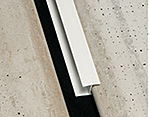 Plastic Components’ new Fiber Cement Board Trims deliver a better finish and cleaner, rustproof job in projects with 5/16″ or 1/2″ cementitious fiber board.
Plastic Components’ new Fiber Cement Board Trims deliver a better finish and cleaner, rustproof job in projects with 5/16″ or 1/2″ cementitious fiber board.
We offer a weeped casing bead and STARTER TRAC™, Z flashing and inside/outside corner for each board thicknesses. These impact-resistant trims protect the edges of the board and manage moisture infiltration.
• Listed by ITS/Warnock-Hersey
Contact Herman Guevara, Director of Worldwide Sales at Plastic Components, Inc. for additional information. Phone: 800 327 7077 Email: info@plasticomponents.com Web: www.plasticomponents.com.
Merkrete Introduces Progrout — New High Performance Premium Grout Offers Color Consistency and More
 Parex USA, Inc., the parent company of leading building material brands; Merkrete, Parex, Teifs, LaHabra and El Rey, announced the launch of Merkrete ProGrout, a premium performance grout.
Parex USA, Inc., the parent company of leading building material brands; Merkrete, Parex, Teifs, LaHabra and El Rey, announced the launch of Merkrete ProGrout, a premium performance grout.
ProGrout is a “high performance” premium, fast setting, polymer-modified, color consistent and efflorescence free grout. It has been specifically formulated for grouting all types of ceramic and dimensional stone tiles on walls and floors when grout joint widths are 1/16″ to 1/2″ wide. ProGrout eliminates the need for sanded and non-sanded grouts.
Advantages of ProGrout include:
• Color Consistency
• Non-Efflorescence
• Fast Setting
• No Shading
• No Blotchiness
“ProGrout is our high end solution for all types of grouting projects,” said Luciano Tavares, Brand Manager for Merkrete. “Color consistency all the way through the joints had been a concern for our end users, so we designed ProGrout with this in mind.”
Now, with the addition of ProGrout, Merkrete brings customers a full range of solutions such as Versatile, Epoxies and Caulking to the market. For over forty years, Merkrete has been dedicated to providing architects, contractors and building owners with the most uniquely diversified and innovative product line in the industry. Merkrete has successfully supplied the building industry with over one billion square feet of tile and stone installation systems backed by our extended warranty programs. From surface preparation and waterproofing, to a complete line of tile installation systems, Merkrete makes it all possible. For more information, please visit www.merkrete.com.
For more information regarding Parex USA, Inc. visit www.parexusa.com.
Merlex Introduces a Continuous Foam Insulation System: Insulex
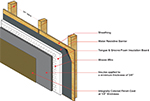 In compliance with the Title 24 requirements:
In compliance with the Title 24 requirements:
- Available sanded or in concentrate form, to be mixed with sand on the job
- Allows for accelerated job scheduling due to reduced wait time between plaster base coats
- Contains 10% post-industrial recycled content
- Optional recycled aggregate for 33% recycled content and LEED credit
- Available One-hour Fire Rating with specified assemblies in ICC ESR-1607 report
- Economical and low-maintenance
- May be used over a variety of substrates, giving architects and builders design flexibility
- May be trowel- or spray-applied
For additional information, contact Merlex, 714 637 1700 or visit www.merlex.com.
Omega Products International Announces Re-release of Travertino
 Omega Products International proudly announces the re-release of Travertino finish. Travertino is a cementitious interior/exterior finish designed to achieve a variety of sedimentary stone appearances, such as travertine, limestone, and sandstone. Travertino can create a pitted look like that of classic Tuscan stone or can be troweled/ground to achieve a smooth stone appearance. Designs can also be carved into Travertino during application, and it can be used to cast special shapes or as a coating over architectural foam shapes. Travertino is an excellent choice to create a beautiful, warm sedimentary stone appearance with a lower cost, lower weight and shorter lead time than real stone.
Omega Products International proudly announces the re-release of Travertino finish. Travertino is a cementitious interior/exterior finish designed to achieve a variety of sedimentary stone appearances, such as travertine, limestone, and sandstone. Travertino can create a pitted look like that of classic Tuscan stone or can be troweled/ground to achieve a smooth stone appearance. Designs can also be carved into Travertino during application, and it can be used to cast special shapes or as a coating over architectural foam shapes. Travertino is an excellent choice to create a beautiful, warm sedimentary stone appearance with a lower cost, lower weight and shorter lead time than real stone.
For additional information, contact Omega Products International, Inc., 951 737 7447 office or visit www.omega-products.com.


